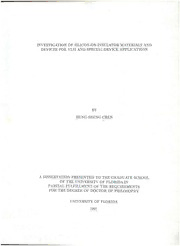
Investigation of silicon-on-insulator materials and devices for VLSI and special-device applications PDF
Preview Investigation of silicon-on-insulator materials and devices for VLSI and special-device applications
INVESTIGATIONOFSILICON-ON-INSULATORMATERIALSAND DEVICESFORVLSIANDSPECIAL-DEVICEAPPLICATIONS BY HUNG-SHENGCHEN ADISSERTATIONPRESENTEDTOTHEGRADUATESCHOOL OFTHEUNIVERSITYOFFLORIDAIN PARTIALFULFILLMENTOFTHEREQUIREMENTS FORTHEDEGREEOFDOCTOROFPHILOSOPHY UNIVERSITYOFFLORIDA 1991 ACKNOWLEDGEMENTS Iwish toexpress mysincereappreciation to thechairman ofmycommittee, ProfessorShengS.Li,forhisguidance,encouragement,andsupportthroughoutthe courseofthisresearch. IwouldalsoliketothankProfessorsDorotheaE.Burk,Gys Bosman, Robert M. Fox,andTimothyJ. Andersonforservingonmysupervisory committee. Iamgratefulto Dr. WadeA. Krullat IbisTechnology Corp. forsupplying devices for my measurements and explaining the processing detailofthe various devices. ThanksareextendedtomycolleaguesFrederickT.Brady,Yi-NanLin,and AndrewTzengfortheirhelpfuldiscussionsandencouragements. Iamgreatlyindebtedtomyparentsandwifefortheirloveandsupportduring thearduousroadofcompletingmyDoctorofPhilosophydegree. Finally,thefinancialsupportoftheFloridaHighTechnologyandIndustryCoun- cil,RADC/HansconAFB,andHarrisCorp. isgratefullyacknowledged. i TABLEOFCONTENTS Page ACKNOWLEDGEMENTS i ABSTRACT v CHAPTER 1 INTRODUCTION 1 1.1Silicon-On-InsulatorTechnology 1 1.2PreparationofSIMOXWafers 2 1.3IntegratedCircuitandNovel-DeviceApplications 3 1.3.1MilitaryIntegratedCircuitApplications 4 1.3.2High-VoltageIntegratedCircuitApplications 5 1.3.3SubmicronCMOSApplications 5 1.3.4Novel-DeviceApplications 7 1.4SynopsisofChapters 8 2 DETERMINATIONOFGENERATIONLIFETIMEPROFILEIN THINSEMICONDUCTORFILMS 12 2.1Introduction 12 2.2CurrentsinReverse-Biasedp-nJunction 12 2.3Theory 14 2.3.1EvaluationofGenerationLayerWidth 14 2.3.2GenerationLifetimeProfileTechnique 16 2.4ResultsandDiscussion 17 2.5Conclusion 21 3 AMODELFORANALYZINGTHEINTERFACEPROPERTIES OFASEMICONDUCTOR-INSULATOR-SEMICONDUCTOR STRUCTURE:CAPACITANCEANDCONDUCTANCE TECHNIQUES 3.1Introduction 31 ii 3.2SmallSignalEquivalentCircuits 32 3.3ExtractionofInterfaceStateParameters 34 3.3.1CapacitanceMethod 34 3.3.2ConductanceMethod 35 3.4CouplingofSurfacePotentials 37 3.5DeterminationofSurfacePotentialVersusGateBias 40 3.6DeterminationoftheSISCapacitorParameters 41 3.7ResultsandDiscussion 42 3.8Conclusion 45 4 AMODELFORANALYZINGTHEINTERFACEPROPERTIES OFASEMICONDUCTOR-INSULATOR-SEMICONDUCTOR STRUCTURE:TRANSIENTCAPACITANCETECHNIQUES 63 4.1Introduction 63 4.2Bias-ScanDLTSTechnique 64 4.2.1CarrierDynamicsoftheSISCapacitor 65 4.2.2Bias-ScanDLTSAnalysis 67 4.3C-tandTemperature-ScanDLTSTechniques 72 4.3.1DecouplingattheF/OandS/OInterfaces 72 4.3.2C-VandC-tAnalysis 72 4.3.3Temperature-ScanDLTSAnalysis 74 4.4Conclusion 76 5 INTERFACESTATECHARACTERIZATIONINSMALL GEOMETRYMOSFET’S 95 5.1Introduction 95 5.2MOSFETEquivalentCircuits 96 5.3StaticandDynamicTransconductanceofMOSFET’s 98 5.4ExtractionofInterfacePropertiesfromtheTransconductance 100 5.4.1High-FrequencyTransconductanceMethod 100 5.4.2Low-FrequencyTransconductanceMethod 101 5.4.3High-LowFrequencyTransconductanceMethod 102 5.4.4DynamicTransconductanceMethod 103 5.5ResultsandDiscussion 103 5.6Conclusion 105 6 DESIGNCONSIDERATIONSFORYIELDENHANCEMENT OFSOIMOSFET’S 116 6.1Introduction 116 6.2StatisticalAnalysisofThresholdVoltage 117 6.2.1ThresholdVoltageofBulkMOSFET 118 m 6.2.2 ThresholdVoltageofThin-FilmSOIMOSFET 118 6.3ResultsandDiscussion 119 6.3.1VariationofOxideThickness 119 6.3.2VariationofDopingConcentration 120 6.3.3VariationofChannelLength 122 6.3.4VariationofFilmThickness 122 6.3.5VariationofTemperature 123 6.4DesignConsiderations 123 6.5Conclusion 125 7 SUMMARYANDCONCLUSIONS 138 REFERENCES 144 BIOGRAPHICALSKETCH 152 IV AbstractofDissertationPresentedtotheGraduateSchool oftheUniversityofFloridainPartialFulfillmentofthe RequirementsfortheDegreeofDoctorofPhilosophy INVESTIGATIONOFSILICON-ON-INSULATORMATERIALSAND DEVICESFORVLSIANDSPECIAL-DEVICEAPPLICATIONS By Hung-shengChen May1991 Chairman: ShengS.Li MajorDepartment:ElectricalEngineering Thisworkdealswiththecharacterization,modeling,anddesignconsiderations ofsilicon-on-insulator(SOI)materialsanddevicesforVLSIandspecial-deviceappli- cations. Itconsistsoftwoparts. Inthefirstpart,severalelectricalcharacterization techniquesaredescribedthatuseteststructuressuchasdiode,capacitor,andMOS- FETforevaluatingthefilmand interfacepropertiesofSOImaterialsanddevices. Inthesecondpart,designconsiderationsforenhancingtheproductionyieldinSOI VLSIcircuitsarediscussed. UsingtheSOIdiodeasatestvehicle,wedevelopadifferentialtechniquethat uses the reverse biased current-voltage and capacitance-voltage measurements for determiningthegenerationlifetimeprofileinthethinsemiconductorfilm. Toeval- uatethetopsiliconfilmand theinterfacepropertiesoftheSOIsubstrate, wede- velopageneralizedmodelforelectricalcharacterizationofasemiconductor-insulator- semiconductor(SIS)capacitorusingstatic,dynamic,andtransientcapacitanceand conductancemethods. Byintroducing a couplingfactor, theconventional metal- oxide-semiconductorcapacitortheoryismodifiedandappliedtoanalyzetheprop- ertiesoftwo Si/SiC>2 interfaces (i.e.,film/buriedoxideand substrate/buriedoxide interfaces)ofaSIScapacitor. Inaddition,wehavealsodevelopedseveralmethods forthecharacterizationofinterfacestatesinasmallgeometryMOSFEToperatingin thelinearregion. Interfacestatedensitiesdeterminedbythehigh-andlow-frequency transconductancemeasurementsforbothbulkandSOIMOSFETsarepresented. TheproductionyieldofVLSIcircuitsisinvestigatedbyexaminingthestatistical variationofthethresholdvoltageinducedbyrandomdistributeddeviceparameters. Theanalysisrevealsthatthin-filmSOIMOSFETislesssensitivetoinherentfluc- tuations indeviceparameters. Design considerationsinminimizingthestatistical thresholdvoltagevariationinSOIMOSFETsarediscussed. Byproperlychoosing thegatematerial,filmthickness,andchanneldopingdensity,enhancementofpro- ductionyieldcanbeexpectedforhighperformanceSOIVLSIcircuits. vi CHAPTER 1 INTRODUCTION 1.1Silicon-On-InsulatorTechnology Thesilicon-on-insulator(SOI)technologieshavebeenunderrapiddevelopment inthepastfewyears. TheSIMOX-based(SeparationbyIMplantationofOXygen) SOImaterialoffers new promiseasleadingtechnologyforhigh-density, radiation- hard,andhigh-performanceintegratedcircuits(ICs). TheusefulSOIpropertiesare basedontheuniquecapabilityoftotalelectricalisolationofsilicon areas andthe reductionofjunctionareas. ThepotentialadvantagesofSOItechnologyoverbulk siliconforadvancedMOSdevicesarenumerous. Theyincludehigherspeed,lower dynamicpowerconsumption,greaterpackingdensity,increasedtransientradiation tolerance,integrationofbipolarandCMOSdevicesonthesamechip,and,forCMOS, freedomfromlatchup. HighqualitySOImaterialisrequiredinordertoachievethepotentialforthis techniqueinICfabrication. ThereareseveralmethodsformakingSOIlayers,but, atpresent,threetechniquesaregenerallybelievedtoholdthemostpromise. These are (i) ion implantation ofoxygen below the silicon surface, (ii) recrystallization ofpolysilicondepositedonathermallygrownoxide,and (iii)waferbonding. The useofahigh-doseoxygenionimplantation,commonlyknownasSIMOX,isoneof themajorcontendersforSOItechnology. SIMOXwafer,unlikeotherSOIwafers, has theadvantagethat thematerialformation is simplyan additional step in an ICfabricationprocess-ionimplantation,furnaceannealing,andepitaxialgrowth. It isaconventional silicon-based technology, and thefabricationofSIMOX-based 1 2 circuits uses processing steps similar to those used in the conventional IC manu- facturing. AlthoughresearchcontinuesonbothSIMOXandrecrystallization-based SOI,SIMOXappearstobemorecompatiblewithconventionalICfabricationpro- cesses than recrystallization-based SOI. Therefore, SIMOX has been moreheavily investigatedanddevelopedthantherestofSOItechnologies. 1.2PreparationofSIMOXWafers ASIMOXwaferispreparedbyimplantingasiliconwaferwithoxygenionsat 150-200keVandtoaniondoseoftypically1.2-2.4 x 1018/cm2(Fig. 1.1). Thedose usedfor this processis about 100 times larger than anyother implant doseused in semiconductorprocessing. This dosetranslates intoaverylongimplant time. Evenwiththehighest-currentimplanter,whichdelivers100mAofbeamcurrent,the oxygenimplantrequiresabout6-7hourstoimplanttwenty-five4” wafers[1]. The temperatureduringimplantisveryimportantsinceinsitudynamicannealingmust occuratthesurfaceofthewafer. Thewaferistypicallyheatedto400°Corhigher duringtheionimplantationprocess. Ahighwafertemperatureensuresthatthefilm retainsitscrystallinityduringthehigh-doseimplantationprocess[2]. Withsuchanextremeimplantsituation,severalothermattersbecomeimpor- tant. Oneisthemetalliccontaminationintroducedduringtheimplant. Sinceoxygen ions areveryreactive, structuresinsidetheimplanterthat canbeexposedtothe ionizedoxygenmustbepassivated,usuallybycoatingwithquartzorsilicon. Never- theless,somemetalliccontaminationispresentwithallimplanters,butthedoseand currentareusuallymuchsmaller,andthecontaminationtendstoscalewithdose. EarlySIMOXwaferwasfoundtohaveveryhighdensity(1x1017/cm3)ofthecom- ponentsofstainless,copper, carbon, andaluminum. Thecontaminationhasbeen reducedabouttwoordersofmagnitudebycarefulcontaminationcontrolinthelater versionoftheoxygenimplantsystem[1], 3 Afteroxygenimplantation,thewaferistypicallyannealedabove1150°Cinan inertambient. Thehigh-temperatureannealrepairsthedamageintroducedduring implantationandallowsexcessoxygeninthesurfacesiliconlayertoout-diffuse,in- creasingthedielectricstrengthoftheburiedoxidelayer. Afterimplantationand anneal, thesurfacesiliconlayeristypically 100-300nmthick. Ifathickersilicon layerisrequiredforICfabrication,anepitaxiallayercanbegrownbyconventional epitaxialtechniques. Thetwotypesofdefectswhicharedominantinthetopsiliconfilmfollowedthe high-temperature annealingare precipitates and threading dislocations. Although precipitatescanbeeasilyremovedbydissolutionduringhigh-temperatureannealing, the threading dislocations once formed are exceedingly stable and are essentially impossibletoremovebythermalannealingalone[3]. Twodifferentapproachescan beidentifiedtoavoidthegenerationofthreadingdislocationsduringannealing: (i) sequentialimplantationandannealingofsubstoichiometricdosesofoxygen,which has been found tobeeffectivein reducingthedislocation density bylimitingthe maximumprecipitatesizeattainedduringtheearlystagesofannealing[4],and(ii) formationofabandoforderedoxideprecipitatestoreducethestressinthisregion andtoconfinethedislocationstoanarrowregionabovetheburiedoxidesothatthey canberemovedastheprecipitatesareincorporatedintotheburiedoxide[5], Mostoftheimplantedinsulatorlayersareformedbyoxygenimplantation,how- ever it is also possible to create a buried insulator layer by implanting nitrogen. Nitrogenhastheadvantageinthatalowerdoseisrequiredtocreatetheinsulator, sothatthesiliconfilmwillbedamagedless. Thecompetingeffectsthatmakethe implantednitrogenapproachmoredifficult includeanarrowwindowofdosesthat areusefulandpossibleadverseeffectsofresidualnitrogeninthesiliconlayer[1], A veryattractiveapproachistheuseofbothoxygenandnitrogenimplantstoforma buriedoxynitride.
